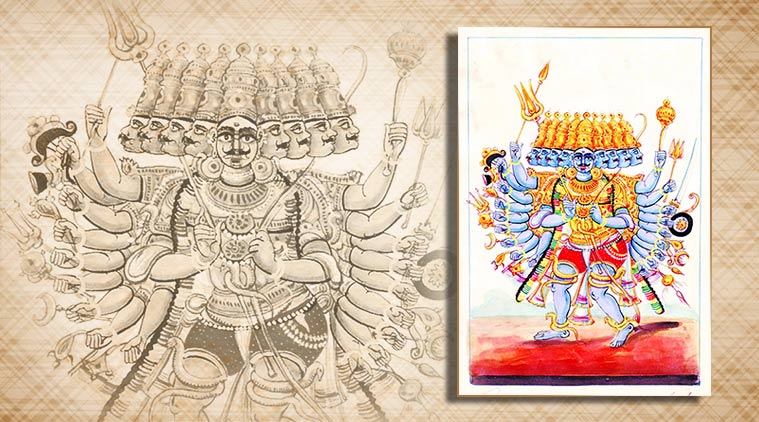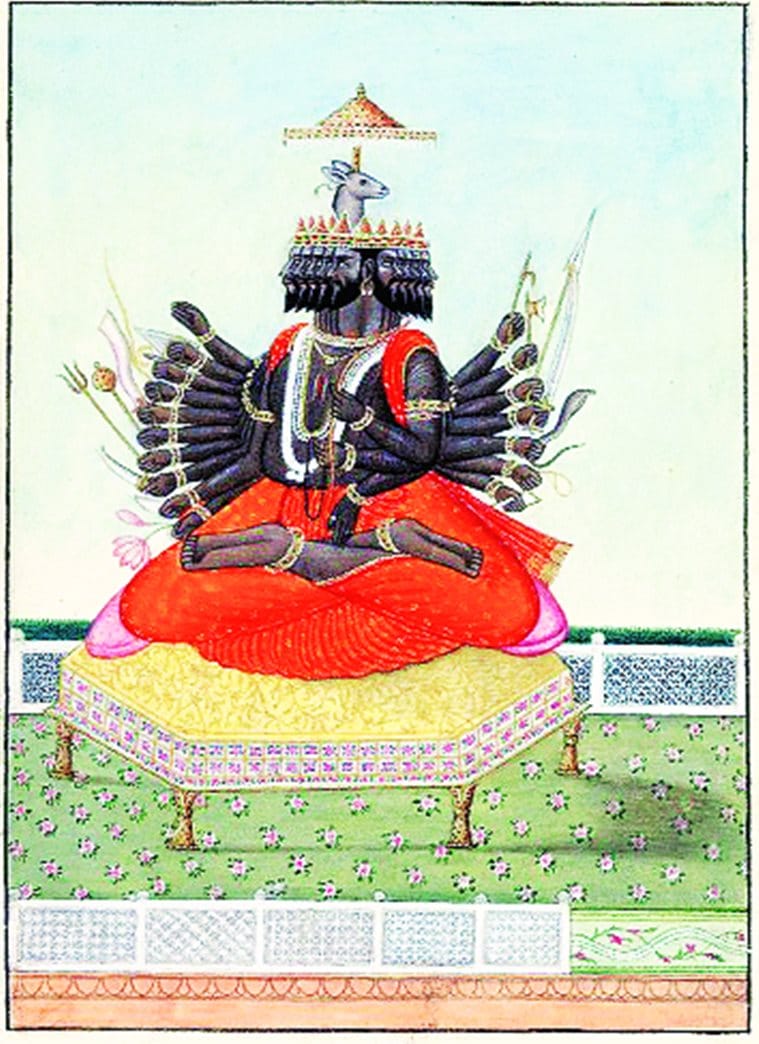Ravana was a spectacular king. He just fell for the wrong girl
Posted on October 27th, 2019
Written by Yudhanjaya Wijeratne Courtesy The Indian Express
The mists of mythology, history and conspiracy theories render him elusive. Yet, in Sri Lanka, the search for Ravana remains a quest for validation.

A few months ago, I was picking my way through an obscure 1870s translation of the great Ramayana, notebook in one hand and my cat attempting to destroy the other. I was on a selfish quest: a friend and I had started writing a story featuring giant robots based on Indian and Sri Lankan gods, and I wanted material for my fictional behemoths.Advertising
The story of Ravana is fairly well-known here in Sri Lanka. Ask any schoolchild above a certain age and they’ll tell you the story — Ravana, the 10-headed, 20-armed mystical king of Lanka, steals Sita, so plucky Rama saddles up with the country-hopping Hanuman to get her back. Above a certain age bracket, they’ll even add more explicit stuff about Sita.
It’s an appealing story. The same pattern repeats itself in hundreds of thousands of movies, books, poems, songs, from Bollywood to Hollywood to the rich depths of Japanese anime, the roles set and the names ever-changing. Ravana is that rich, arrogant high-school villain who steals your girl. Rama is the hero who wins her back. The story is very clear: Ravana is the bad guy.
Except, this supposed villain weaves himself into my native Sri Lanka in a distinctly un-Voldermort-like pattern. Return to those schoolchildren and ask them: was Ravana a tyrant? They’d probably be surprised. No, they’d say. Ravana was a spectacular king. Just fell for the wrong girl. Speak to monks and scholars of history and you see a theory — that Ravana was a real king who ruled Lanka around 2517 BC. A great scholar, well-versed in mathematics and urban design, who ruled his kingdom and did well; and that like the British king Arthur, he passed from history to legend, from legend to myth, and ended up being unfairly cast as the villain in a domestic squabble.Advertising
The Ramayana I was reading seemed to nod its head. The villain of the story, after all, is painted in extraordinary colour, a king with 10 heads to represent his knowledge of the shastras and the Vedas, a dab hand on the veena, an astute political scientist and sage, with a boon from Brahma. This is no ordinary Voldemort. If anything, Rama pales in comparison — a golden boy written in straight lines and with little subtlety.
Depending on who you ask, the stories get ever more fanciful. It was Ravana who invited the Kashyapa Buddha to Sri Lanka, say some. It was Ravana who ran the first, technologically superior kingdom here in Sri Lanka, say others; read the Ramayana carefully, does this part not sound like a nuclear power plant? It was Ravana who first had powered flight — how else did he get Sita down here from India?
In fact, the Sri Lankan civil aviation authority, in a bid to investigate this very question, launched a project in August to probe deeper into the matter. The forum argued about why Indian historians never talk about the Pushpaka Vimana (or, in Sinhala, the Dandu Monara Yanthraya: the Peacock Machine). The head of the archeological institute of a prominent university, and a professor of geography, were firm in their opinions that Sri Lankans flew 5,000 years ago, thanks to Ravana, and that adequate scientific detail could be found. A venerable monk claimed that the Yakka language — an ancient indigenous dialect — would have been the lingua franca during Ravana’s times, and that we should dig deeper into those legends. It was said that Valmiki, the author of the Ramayana, did a con job on a great man.

Stray a little bit beyond these officially sanctified waters and theological debates and you run head-first into the ominous-sounding Sri Ravana Research Institute and the Sri Ravana Central Intelligence Agency, both of which seem to be involved in some Illuminati-level plot of unlocking the mystical potential of humans and getting us to Mars.
One would assume this is an obsession of an older generation. Not so. On YouTube, the Ravana brothers are producing rich, lyrical music, fusing old Sri Lankan styles with new beats: I have no idea who they are, but they’re good. A friend once wrote a novel about Ravana during his school days, briefly holding the dubious title of being the youngest published author in the country. Another friend, a rapper-poet, recently did a skit in Germany about how Ravana was the better lover. Earlier this year, Sri Lankan researchers at the Kyushu Institute of Technology in Japan launched a satellite called Raavana-1.
Earlier this year, the monk who leads the Ravana Balakaya — a nationalist hate group with parliamentary affiliations — stood in front of the police headquarters, threatening to surround the building if his complaint against a Muslim minister was not acted upon. Behold a news report on it: When guards prevented the hardline monk from entering the HQ with his mobile phone, he stood outside the building and threatened to surround the building if his complaint about Minister Rishard Bathiudeen was not investigated by ‘Wednesday or Thursday’ next week. Pointing in the direction of the CID offices, the monk threatened SSP Abeysekera, saying that he would be taught a ‘proper lesson’ in three months. ‘Across the road there is a fellow called Shani. He has arrested 28 army officers including captains and majors and colonels. Just wait, he has only three more months and then we will teach him a proper lesson,’ the Ravana Balakaya convenor charged.”
Honestly, as a science fiction author, this stuff sometimes goes from interesting to amusing to irritating to deeply troubling. Out of the mists of history and conspiracy theories, Great Ravana reaches out with a dead hand, mocking my imagination. A fellow called Shani follows. Ravana is the Lee Kuan Yew of Sri Lanka, a thousand times more powerful, 10,000 times more elusive, a symbol of glory for an island struggling to find its feet. He is the Sri Lankan Ozymandias, looking back through the mists of time, bellowing Look upon my works, ye mighty, and despair!”
Having successfully fought the cat off, I returned to my notebook, and began sketching. A 10-headed machine, the last symbol of Sri Lankan surveillance state, fighting for its life over the Bay of Bengal; my pen traces lightning in his wake, and spears of depleted uranium turn the ocean into a dark, churning, radioactive froth. And another legend is added.
Ravana slumbers on.
This article first appeared in the print edition on October 27, 2019 under the title ‘The Ozymandias from Lanka’. Wijeratne is a Sri Lankan science fiction author, data scientist and TEDx speaker, best known for Numbercaste and The Inhuman Race. He is the first Sri Lankan to be nominated for the Nebula Award.